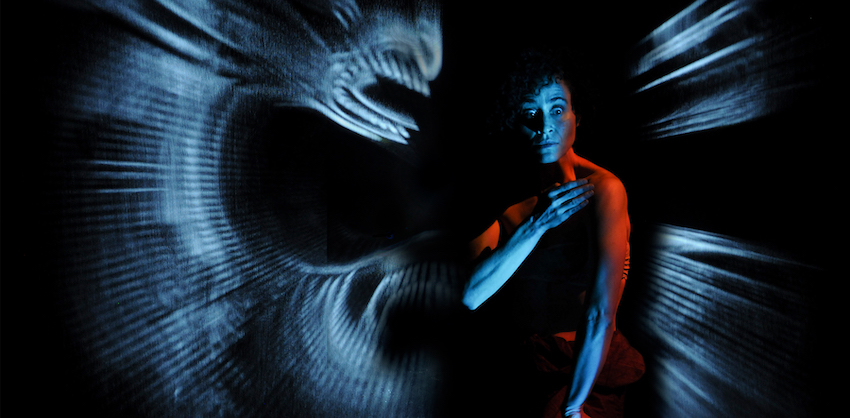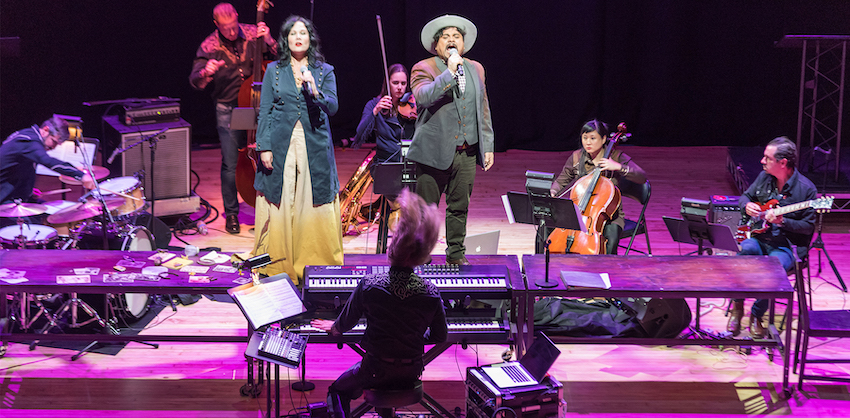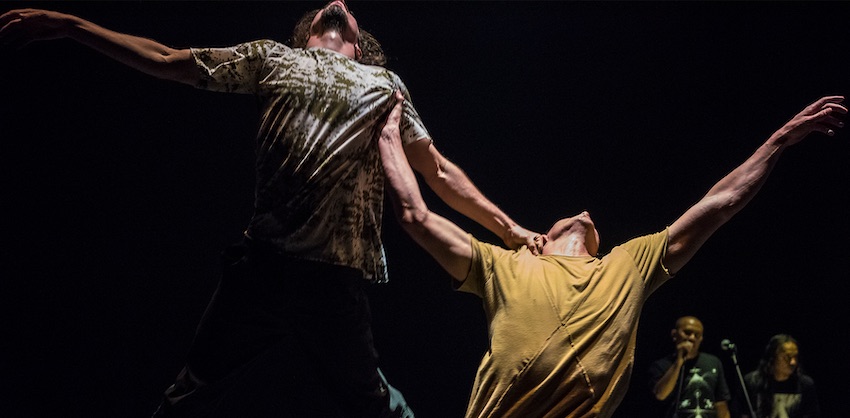Putting together a major festival is a little like having a baby.
The thing is conceived in a moment of passion and high spirits, then comes the gestation period as details come together, and finally the moment comes to, well, push.
Hard labour begins. The baby is crowning, eager to enter the world, so begins long nights of screaming and groaning and then, lo, a festival is born!
The PuSh Festival in Vancouver is enjoying its 15th anniversary, and if the idea of producing a 15-year-old baby makes every woman in the world wince, be assured that attending the festival isn’t a painful process. Just the opposite, in fact.
PuSh presents works of live performing arts and is filled with fun, adventure and some challenge. But what’s of value that doesn’t require a bit of effort?
On the eve of the festival’s opening I spoke with interim artistic director Joyce Rosario about what she’s excited about, how to prepare for the long haul and which shows you should trample over your grandmother to get tickets for.
‘Attractor’
Let’s start with some dancing. I’m not talking about the timid, traipsing-about-on-tippy-toes kind of stuff, but sweaty, wild, quasi-insane movement that could either end in sex or violence, perhaps both.
Find it in Attractor, which has performances tonight (Jan. 18) and tomorrow (Jan. 19). Even the briefest glimpse of this work is enough to set your hair on fire.
As Rosario writes in her curatorial statement, it’s also the kind of conflagration — Iron Maiden meets Indonesian cultural tradition — that is typical of PuSh: “Attractor was born out of intrigue after director Gideon Obarzanek travelled to a village in Eastern Java to observe a traditional dance ceremony. Wondering why he, and other seemingly non-religious people, were drawn to the ceremonial performance, Obarzanek concluded that participants become part of something bigger than themselves in transcendent states.”
Joyce says that the work reminds her of ’90s rave culture and the curious form of ecstasy that can only come from dance. “It’s secular form of ritualistic behaviour but from Indonesian traditions. From this state of ecstasy comes a potentially transformative experience.”
A band performs live onstage with the dancers, and the production also involves some audience participation. So introverts beware. Or maybe just hide out in the back row. Dance, whether it’s ballet or contemporary work, is often intimidating for people, whereas dancing at clubs or raves isn’t. Why are people afraid of dance, I ask?
“I think comes from being not in touch with our bodies, especially in Western society,” muses Rosario. “We’ve lost the ability of feeling it in our body.” Which is why work like Attractor, with its mix of different elements and potential for cathartic release is so fascinating. Dance and trance go well together; just ask any kid who came of age in the ’90s.
‘Copper Promises’
PuSh has always tugged, prodded and hammered at the boundaries of performance, travelling to different events and showcases around the globe to see exciting stuff and then bringing it home to Vancouver audiences.
Another work that looks compelling is Copper Promises – Hinemihi Haka. Victoria Hunt, who is of Māori heritage, presents a non-Western form of dance that incorporates theatre, projected image and Indigenous art-making.
Hunt spent a decade researching for the work, combining her own history with that of a distant ancestor named Hinemihi to fashion a performance that is raw with emotion and pain.

Dance hotbeds tend to move from country to country. One year Israel is the place to be, the next it’s Denmark, but Hunt, along with artists like Jacob Boehme, is at the forefront of a new wave of Indigenous performance artists.
I ask Rosario how far out she begins to look for and identify trends in programming for a festival like PuSh?
“That’s shaped by so many things. It’s about who is promoting work of artists. This year there is a strong Australian presence. But there’s always strong contingent from the U.K., partly because of the colonial connection but also because the British Council really supports artists. Attending the Edinburgh festival means you’re going to see a lot of U.K. work. That factors pretty significantly, because in order to see work, there has to be a level of support.”
‘Loop Lull’
There’s also plenty of local work on display, like Company 605 with its performance, Loop Lull.
“You have to know who’s out there and be looking for new platforms for local work. You also have to have an understanding of how the two (local and international work) can complement each other,” Rosario explains.
Although a number of dance companies from Vancouver have broken through on the international stage — Kidd Pivot, The Holy Body Tattoo — other local performing artists haven’t had the same level of recognition. And international success doesn’t mean local recognition. Some of Vancouver’s more celebrated artists are far better known outside of the city than they are on their home turf.
But is Vancouver particularly prone to the tall poppy syndrome — artists who are respected abroad and ignored at home?
Rosario isn’t so sure, but says that a creative scene can develop quite quickly with the right impetus. When PuSh launched in 2003, the idea of an international festival dedicated to performance seemed a risky notion. But 15 years later and PuSh has grown into a strapping event.
“It was really interesting to revisit The Holy Body Tattoo’s dance performance Monumental (offered at the 2016 PuSh Festival with an onstage performance from God Speed You! Black Emperor) and see how the work has evolved.”
I too remember this encore performance, some 11 years after its initial presentation in Vancouver, and how both the work and the audience had ostensibly changed during this time.
‘Pancho Villa’, ‘Race Cards’ and ‘Salt’
PuSh’s particular appeal comes from the combination of different kinds of work — high and low, weird and wonderful, and, occasionally, terrifying. Last year’s performance of The Eternal Tides featured a bloodcurdling moment of raw terror.
PuSh is still adding new programming streams and partnering with different organizations in the city like the Vancity Theatre to offer a film series alongside the performing arts events.
You can take in a small intimate experience like that offered at Club PuSh or blow it out big on stage at the Vogue Theatre. A fine example of this brand of cultural fusion is Pancho Villa From a Safe Distance, described as a “bilingual, cross-border, cross-genre opera about the enigmatic general, legendary bandit and hero of the Mexican Revolution.”

What should people not miss? Joyce’s answer is immediate and impassioned: “Pancho Villa! Please come see this, it’s so necessary, and so timely!”
The work, commissioned by Ballroom Marfa, brings together a remarkable collection of different artists including composer Graham Reynold and librettist Lagartijas Tiradas al Sol, who use the figure of Pancho Villa and a healthy lashing of music to examine the relationship between the U.S. and Mexico.
Joyce is equally enthusiastic about Race Cards, Selina Thompson’s installation that uses 1,000 sequentially numbered index cards, each with a question about race to examine beliefs and prejudice. Visitors are encouraged to read as many cards as they can onsite, but also to answer one question and take another with them when they go. The installation, at the Roundhouse in Vancouver, is free and open to the public from Jan. 23 to Feb. 2.
Thompson is also presenting a performance work entitled Salt that recreates the African diaspora and the transatlantic slave trade. Thompson, who is based in Leeds in the U.K., uses performance to get to the roots of marginalized communities, presenting shows in pubs, hair salons and even toilets. Joyce describes her work as “deceptively simple. It’s very hard and tough, but also light and irreverent.”
And with that, a new festival baby is born. Prepare yourself for the wealth and joy of new experiences yet to come. ![]()
















Tyee Commenting Guidelines
Comments that violate guidelines risk being deleted, and violations may result in a temporary or permanent user ban. Maintain the spirit of good conversation to stay in the discussion.
*Please note The Tyee is not a forum for spreading misinformation about COVID-19, denying its existence or minimizing its risk to public health.
Do:
Do not: